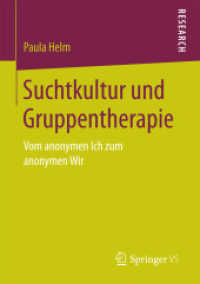- ホーム
- > 洋書
- > 英文書
- > Science / Mathematics
Full Description
Understanding radionuclide behaviour in the natural environment is essential to the sustainable development of the nuclear industry and key to assessing potential environmental risks reliably. Minimising those risks is essential to enhancing public confidence in nuclear technology. Scientific knowledge in this field has developed greatly over the last decade.Radionuclide behaviour in the natural environment provides a comprehensive overview of the key processes and parameters affecting radionuclide mobility and migration.After an introductory chapter, part one explores radionuclide chemistry in the natural environment, including aquatic chemistry and the impact of natural organic matter and microorganisms. Part two discusses the migration and radioecological behavior of radionuclides. Topics include hydrogeology, sorption and colloidal reactions as well as in-situ investigations. Principles of modelling coupled geochemical, transport and radioecological properties are also discussed. Part three covers application issues: assessment of radionuclide behaviour in contaminated sites, taking Chernobyl as an example, estimation of radiological exposure to the population, performance assessment considerations related to deep geological repositories, and remediation concepts for contaminated sites.With its distinguished editors and international team of expert contributors, Radionuclide behaviour in the natural environment is an essential tool for all those interested or involved in nuclear energy, from researchers, designers and industrial operators to environmental scientists. It also provides a comprehensive guide for academics of all levels in this field.
Contents
Contributor contact detailsWoodhead Publishing Series in EnergyForewordChapter 1: Overview of radionuclide behaviour in the natural environmentAbstract:1.1 Introduction1.2 Radionuclides of interest1.3 Environmental compartments to be considered1.4 ReferencesPart I: Radionuclide chemistry in the natural environmentChapter 2: Fundamentals of aquatic chemistry relevant to radionuclide behaviour in the environmentAbstract:2.1 Introduction2.2 Composition of natural waters2.3 Dissolution and precipitation2.4 Aqueous complexes2.5 Surface sorption2.6 Colloids2.7 Redox reactions2.8 ReferencesChapter 3: Aquatic chemistry of the actinides: aspects relevant to their environmental behaviorAbstract:3.1 Introduction3.2 Oxidation states of actinides in aqueous solution3.3 Actinide solid phases and solubility phenomena3.4 Actinide complexation reactions3.5 Chemical modeling tools and thermodynamic databases3.6 Recommended literature3.7 ReferencesChapter 4: Aquatic chemistry of long-lived mobile fission and activation products in the context of deep geological disposalAbstract:4.1 Introduction4.2 The effects of the near field in high-level radioactive waste disposal4.3 Solution and interfacial chemistry of selected radionuclides4.4 Summary4.5 ReferencesChapter 5: Impacts of humic substances on the geochemical behaviour of radionuclidesAbstract:5.1 Introduction to humic substances5.2 The 'humic acid molecule'5.3 Discrete models of metal ion-humic interactions5.4 Multiligand and macromolecular models of metal ion-humic interactions5.5 Kinetic models of metal ion-humic interactions5.6 Impacts of humic substances on radionuclide transport in different sites worldwide5.7 Conclusions and future trends5.8 ReferencesChapter 6: Impacts of microorganisms on radionuclides in contaminated environments and waste materialsAbstract:6.1 Introduction6.2 Biotransformation of uranium6.3 Biotransformation of plutonium6.4 Biosorption and bioaccumulation of uranium and plutonium6.5 Biotransformation of other actinides and related elements6.6 Biotransformation of fission and activation products6.7 Microbiological studies of low- and intermediate-level wastes, and high-level waste repository sites6.8 Conclusion6.9 Acknowledgments6.11 ReferencesPart II: Radionuclide migrationChapter 7: Hydrogeological features relevant to radionuclide migration in the natural environmentAbstract:7.1 Introduction7.2 The water content of the subsoil7.3 Groundwater movement in the soil and subsoil7.4 Aquifer systems7.5 Groundwater flow equations for aquifer systems7.6 Solving the flow equations for aquifer systems7.7 ReferencesChapter 8: Radionuclide retention at mineralaEURO"water interfaces in the natural environmentAbstract:8.1 Introduction8.2 Macroscopic studies of radionuclide sorption8.3 Sorption models8.4 Spectroscopic techniques8.5 Future developments8.6 Acknowledgements8.7 ReferencesChapter 9: Radionuclide migration: coupling transport and chemistryAbstract:9.1 Introduction9.2 The transport phenomenon9.3 Coupling chemistry to transport9.4 Application examples9.5 ReferencesChapter 10: Impact of colloidal transport on radionuclide migration in the natural environmentAbstract:10.1 Introduction10.2 Geochemistry and sorption behavior of radionuclides10.3 Nature and origin of colloids10.4 Colloid characteristics10.5 Laboratory experiments of colloid-facilitated radionuclide transport10.6 Field studies of radionuclide migration10.7 Conclusion and future trends10.8 Acknowledgments10.9 ReferencesChapter 11: Natural analogues of nuclear waste repositories: studies and their implications for the development of radionuclide migration modelsAbstract:11.1 Introduction11.2 Nature and limitations of natural analogues11.3 Selected natural analogue sites11.4 Lessons on radionuclide (RN) geochemistry and migration from main natural analogues studies11.5 Conclusion11.6 Acknowledgement11.7 ReferencesChapter 12: Studying radionuclide migration on different scales: the complementary roles of laboratory and in situ experimentsAbstract:12.1 Introduction12.2 Designing laboratory studies at different scales on radionuclide diffusion in underground environments12.3 Studies at different scales on diffusion in Swiss Opalinus Clay12.4 Studies at different scales on diffusion in French Callovo-Oxfordian claystone12.5 Laboratory experiments at the decimetre-scale on the transport of radionuclides in non-consolidated porous media12.6 Conclusions and future trends12.7 References12.8 Appendix: definitions and abbreviationsChapter 13: Radionuclide transfer processes in the biosphereAbstract:13.1 Introduction13.2 Radionuclide speciation and interactions with biological ligands13.3 Transfer to plants and biodistribution13.4 Transfer to animal species and biodistribution13.5 Transfer to man13.6 Effect on metabolic pathways13.7 Transfers through epithelial barriers: the digestive barrier13.8 Membrane transport13.9 Intracellular mechanisms: homeostasis and stress13.10 Future trends13.11 Acknowledgements13.12 ReferencesPart III: Environmental impact and remediationChapter 14: Modelling radionuclide transport in the environment and calculating radiation dosesAbstract:14.1 Introduction14.2 Modelling radionuclide transport in the environment14.3 Assessing radiation doses to humans14.4 Assessing radiation doses to non-human biota14.5 Achieving a comprehensive assessment14.6 Conclusion and future trends14.7 ReferencesChapter 15: Quantitative assessment of radionuclide migration from near-surface radioactive waste burial sites: the waste dumps in the Chernobyl exclusion zone as an exampleAbstract:15.1 Introduction15.2 The Chernobyl Pilot Site in the Red Forest15.3 Modelling radionuclide migration in the aquifer considering stationary hydrodynamic and geochemical conditions15.4 Prediction of 90Sr migration, assuming non-stationary hydro-biogeochemical conditions15.5 Conclusions and future trends15.6 Acknowledgements15.7 ReferencesChapter 16: Remediation of sites contaminated by radionuclidesAbstract:16.1 Introduction16.2 Potential sources of radionuclide release16.3 Methods of cleaning contaminated sites16.4 Environmental monitoring tools16.5 Modelling tools for planning clean-up16.6 Risk assessment studies of hazardous sites and clean-up measures16.7 Examples of remediation of contaminated sites16.8 Sources of further information16.9 ReferencesChapter 17: Safety assessment of nuclear waste repositories: a radionuclide migration perspectiveAbstract:17.1 Introduction17.2 Repository concepts17.3 Safety assessment (SA) methodology17.4 Integration of the main radionuclide migration processes and parameters in the safety assessment (SA) models17.5 Gaps in understanding and the qualification and quantification of the safety assessment (SA) models17.6 Conclusions17.7 Acknowledgements17.8 ReferencesIndex







